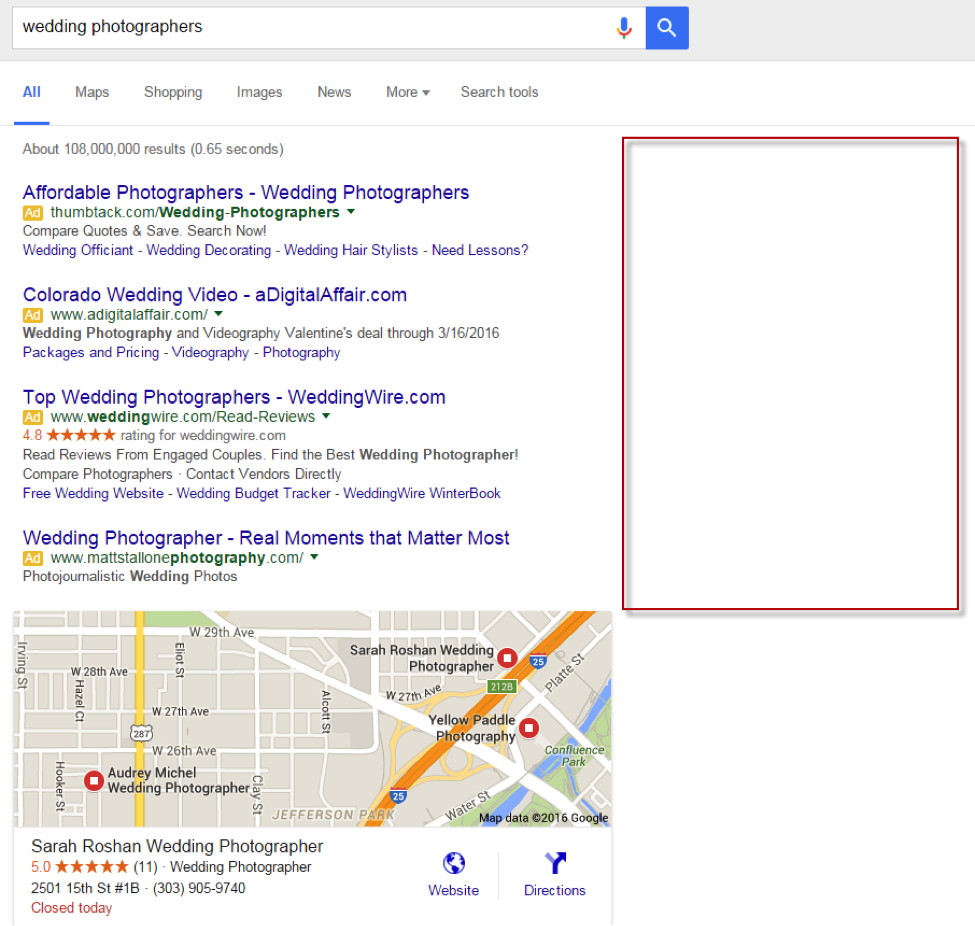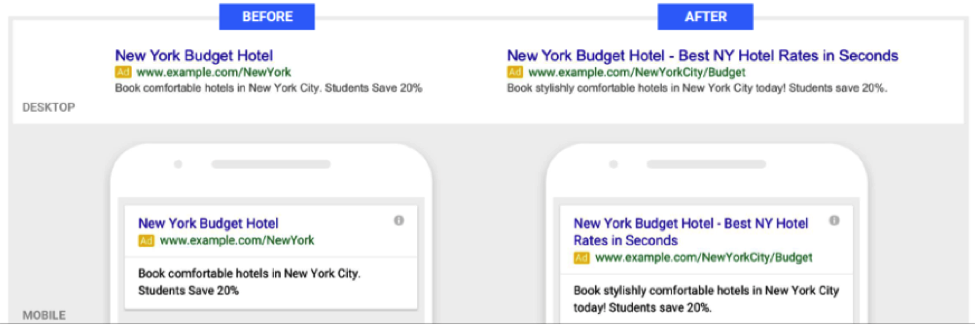Advertisers no doubt recall the upgrades to targeting and analytics that Google made throughout the year; but what about the humble user, who is rarely privy to the backend changes that alter how he searches on the web?
This year more than those past, the average Googler has witnessed several impactful changes to his search engine results page (SERP). Considering its steep competition, the legal industry is especially susceptible to changes in Google’s SERP. Adapting your law firm’s digital marketing approach to this year's most important updates will help you set the stage for success in 2017.
No More Right-Hand Rail
The most noticeable change to Google SERPs is undoubtedly the removal of ads along the right side.
Google has included right-hand side ads on its results page since the inception of AdWords 17 years ago. Though the network is famous for keeping its algorithm updates thoroughly under wraps, it’s infrequent that Google makes a change this impactful to its enduser.
Google sunset the “right-hand rail” ad placement halfway through Q1, decreasing the maximum number of ads on the page from 11 to 7. Google also added an additional ad placement above organic results that displays when a query has high commercial intent. Users now only see ads directly above and below organic results with the exception of some Shopping campaign ad formats.

Image via Word Stream
The removal comes as a result of nearly 6 years of testing which concluded that click-through-rate (CTR) of right-hand rail ads were significantly lower than that of ads positioned above and below organic results.
Many marketers grumbled that fewer ads on the page would cause higher cost-per-clicks (CPCs) and speculated that inspiration for the change was profit-minded. Because only 7 ad placements appear on each page, law firms may need to adjust their keyword bids to ensure ads remain in their most profitable positions.
It’s not all bad news, however. The removal of right-hand rails actually benefited ads in position 4. Now appearing above organic results in purchase-minded searches like “find a will attorney online,” ads in position 4 experienced a significant lift in CTR; this can drive additional conversions, improve an ad’s average position, and increase keyword Quality Score.
Attorneys marketing their services will want to take note of keywords in positions 5.0 or greater – it may actually decrease your cost per conversion to increase your bid to achieve 4th position.
Green Ad Labels
Near the onset of Q3, Google changed its ad label from yellow to green. Used to differentiate paid results from organic ones, these ad labels follow guidelines set by the FTC to protect consumers who search online.
According to a public statement, Google’s shift to green was to unify the colorscape of mobile and desktop SERPs. The shade of green should feel familiar, after all; the display URLs of both paid and organic results have long been that very same shade of green.

Image via SearchEngineLand
The new green ad label exemplifies Google’s commitment to “Mobile First.” If you’re unfamiliar with the approach, it comes in response to the rise of mobile activity among consumers. Not so long ago, displaying ads on mobile devices was a supplement to online marketing campaigns that relied on desktop traffic. Now we have entire strategies, entire job roles, and entire fields of study dedicated to a consumer’s mobile journey.
Legal practices advertising on Google should take this to heart when considering mobile strategy. If your ads do not bring users to a mobile responsive webpage, now is the time to develop mobile-specific practices. Google changing desktop SERPs to resemble mobile SERPs is further proof that mobile is no longer desktop’s sidekick.
Expanded Text Ads
A subtle change for consumers has been the release of a new text ad format in early Q2. Expanded Text Ads (ETAs), as the name suggests, allow a greater amount of text compared to their predecessor, the Standard Text Ad (STA). The ETA features two headlines, a longer display URL, and a longer ad description.

Image via AdWords
Advertisers rejoiced over the slightly relaxed character limits of ETAs, but the change didn’t create newsworthy buzz for Google’s users like removing right-hand rail ads did.
Reason for this may be that ETAs don’t immediately appear all that different from what users have already seen. The most identifiable characteristic of an ETA is a double headline, and Google has long shown text to the right of an STA’s headline—a result of “bumping up” text from an ad’s description or from auto-inserting a landing page’s domain name.
For advertising legal services, ETAs mean attorneys can now flex their writing chops. Google urged advertisers to revise entire ad copy strategy for the longer format, so this means re-writing your ads to convert instead of simply appending extra text. With the extra space to communicate your firm’s services, be sure to create ads tailored to keyword searches as well as to the value your practice can genuinely provide.
Though both ad formats serve alongside each other for the time being, Google stated that AdWords will no longer support the creation of new STAs at the end of January, 2017 – a deadline that affirms ETAs are here to stay.
Looking Forward
Based on what we’ve seen in 2016, Google will continue to optimize its search network for mobile users. For legal marketers in 2017, this means steep competition for the limited ad positions eligible to display on mobile devices; non-standard conversion paths that involve multiple stages of research and multiple devices; and a greater volume of unique long-tail and question-oriented searches.
Few beyond Google executives are likely to know what the next big change to SERPs will be; all we know for sure is that optimizing campaigns to Google’s updates is the best way to succeed in search engine marketing’s changing landscape.
If You’re Overwhelmed…
If you don’t want to optimize your firm’s marketing approach for changes to Google’s SERP, you can always supplement case volume with leads from a third-party lead generation company like eGenerationMarketing. We specialize in search engine marketing, staying abreast of industry trends so you don’t have to – all while keeping your cost per lead as low as possible.
If you’re interested in learning more about our products, which include Social Security disability, personal injury, workers’ compensation, and employment law leads, contact out to us at 617.800.0089.